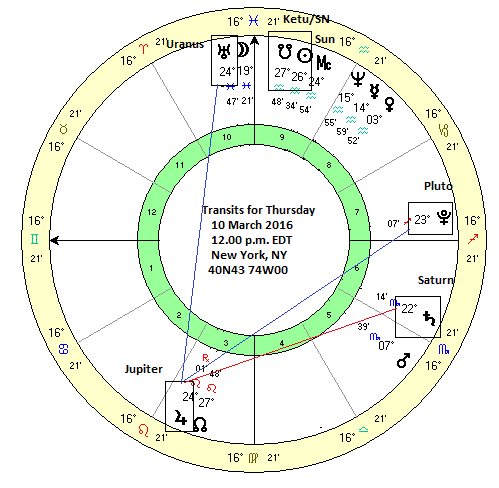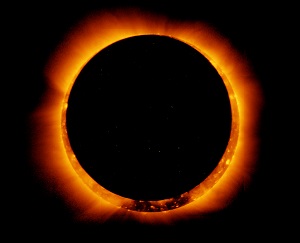 (7 March 2016)
Since time immemorial, eclipses have been regarded with dread and
fear. The inexplicable period of daytime darkness brought by the solar
eclipse was seen by pre-scientific societies as an evil omen and the
harbinger of all manner of disaster and privation. Similarly, lunar
eclipses were also looked upon with suspicion as the comforting glow of
the luminous Moon suddenly turned dark and changed to an evil red
colour. While we now live in an enlightened age of computers marked by
exponentially expanding scientific knowledge, eclipses remain singular
and wondrous celestial phenomena. Even beyond their aesthetic allure,
eclipses retain a undeniable mystique. They link us with our primitive
past and recall a time when the heavens were a source of earthly
inspiration. As another solar eclipse is due on Wednesday (with
totality in Indonesia), it is a good time to remind ourselves of the
astrological legacy of eclipses.
(7 March 2016)
Since time immemorial, eclipses have been regarded with dread and
fear. The inexplicable period of daytime darkness brought by the solar
eclipse was seen by pre-scientific societies as an evil omen and the
harbinger of all manner of disaster and privation. Similarly, lunar
eclipses were also looked upon with suspicion as the comforting glow of
the luminous Moon suddenly turned dark and changed to an evil red
colour. While we now live in an enlightened age of computers marked by
exponentially expanding scientific knowledge, eclipses remain singular
and wondrous celestial phenomena. Even beyond their aesthetic allure,
eclipses retain a undeniable mystique. They link us with our primitive
past and recall a time when the heavens were a source of earthly
inspiration. As another solar eclipse is due on Wednesday (with
totality in Indonesia), it is a good time to remind ourselves of the
astrological legacy of eclipses.In astrology, eclipses are still hugely important. Just as the light from the Sun temporarily disappears from view, eclipses are seen as interruptions of the status quo. Instability and change are often stressful and therefore eclipses may be more likely to bring about shifts in our routine, for better or worse. While traditional eclipse symbolism focuses on the negative impact of change and forced adaptation to new circumstances, evidence suggests that some eclipses bring about positive change.
For example, the last solar eclipse before the 2008 US election occurred on August 1st just three days before President Obama's birthday. In other words, the solar eclipse occurred at 15 degrees of sidereal Cancer, just four degrees short of the position of his natal Sun at 19 Cancer. The Sun symbolizes leadership and status and hence Obama's status was soon to undergo a significant change after the eclipse at the time of the November election. We can even see how the election of first black President occurred after a solar eclipse that closely conjoined Rahu (15 Cancer) in the USA horoscope (not shown). Vedic astrology teaches us that Rahu (North Lunar Node) represents outsiders, especially those who differ from the mainstream in terms of their religion, ethnicity or race. Barack Obama was therefore the embodiment of this Rahu influence with respect to the USA.
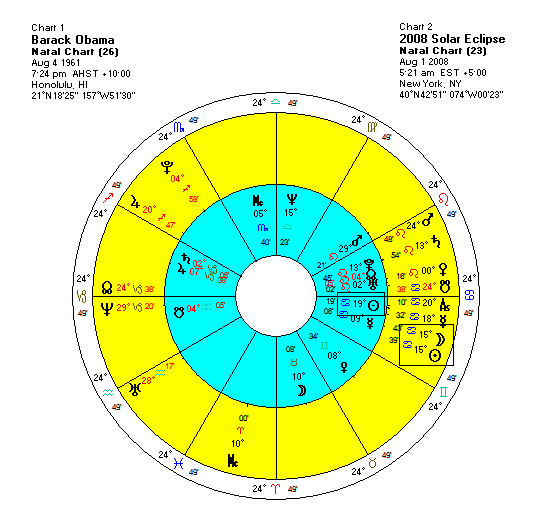
In a more ominous vein, the last lunar eclipse before the assassination of John F. Kennedy closely conjoined the Sun in the USA horoscope. The July 6 lunar eclipse occurred at 20 Gemini, just two degrees from the Sun (22 Gemini) in the USA chart. The eclipsing of a nation's Sun may be interpreted most generally as "sudden changes to leaders" without necessarily pointing to death. Other factors no doubt had a hand in shaping the larger planetary picture of that terrible event. In JFK's own horoscope, the last solar eclipse before his death occurred on July 20th at 4 Cancer -- exactly conjunct his 10th house Saturn, the planet of loss and suffering.
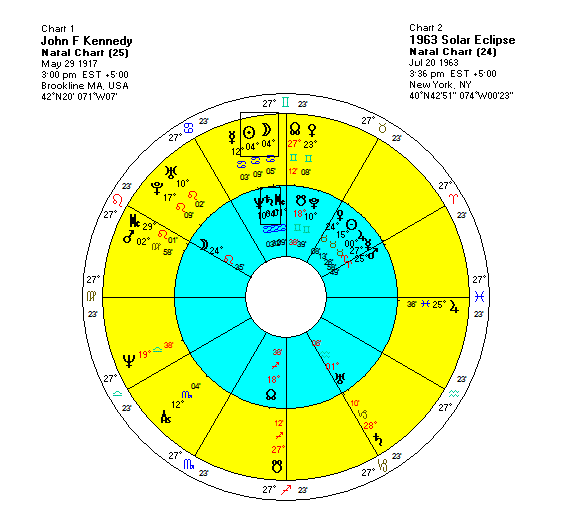
It may be worth noting that the last lunar eclipse before this year's US election occurs on September 16th at 0 Pisces which is exactly conjunct Hillary Clinton's Moon if we use the 8 a.m. birth time for her (Her birth time is contested). This would seem to point to a sharp increase her public profile in the period following the eclipse at election time. It seems broadly supportive of an election win. However, this eclipse is not aligned with the Venus (= women) in the USA horoscope as we might expect so that is perhaps one small piece of evidence that argues against her becoming president.
The ups and downs of the stock market also provide a fertile laboratory to test the effects of eclipses on collective human sentiment. Following our basic assertion, we can suggest that eclipses are neither inherently positive or negative for stocks. Rather, it may make more sense to think of them as indicators of a trend change. While I have not conducted an extensive research of eclipse effects, my basic view suggests that the two-week eclipse period seems to correlate with trend changes more than chance would predict.
It is important to think of eclipses occurring in pairs (solar and lunar) which are separated by about 14 days. The period is best taken as a time block although trend changes may cluster around one eclipse or the other. But eclipses seem to predict trend changes only about 50% of the time. Alas, there are many eclipses that don't have any apparent effect on stocks at all.
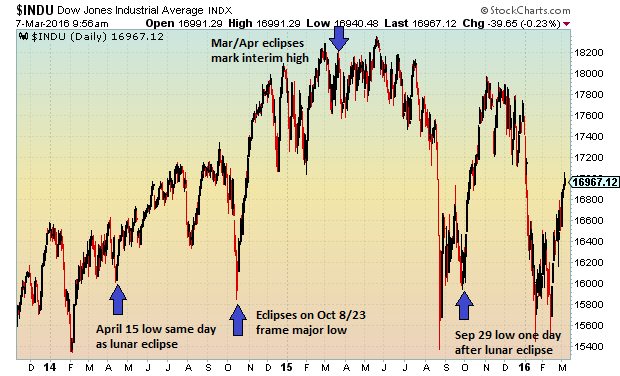
This two-year chart of the Dow Jones Industrial Average ($INDU) shows how eclipses appear to correlate with the market. The previous eclipse period in September 2015 fit quite nicely with the bottoming process of the market after the big decline in August. After the lunar eclipse on September 28th, markets began to rebounded strongly. The significant interim low occurred just one day after the second eclipse of the pair. In this case, the eclipse period reflected a sense of uncertainty and instability and only after the eclipses were over did the market begin to rise as investors regained their confidence.
However, the precious eclipse period in March-April 2015 didn't correlate with anything much in US markets. Stocks moved mostly sideways,. although they were very close to their high. On the other hand, some global markets did indeed peak around this eclipse period. Germany's DAX made its all-time high on April 10th just six days after the lunar eclipse while India's Sensex peaked on March 4th some two weeks before the solar eclipse. In this case, the eclipse period occurred after a rally and therefore may have signaled a trend change from a rising market to a falling one.
The October 2014 eclipse period also correlated quite closely with the bottom in most stock markets. The low for most markets occurred on October 15th which was right in the middle of the eclipse period of October 8-23. While neither eclipse was closely predictive of the low and subsequent reversal higher, the period as a whole nonetheless fit well with the trend change. This low and subsequent trend change occurred across most global stock markets in mid-October 2014.
The preceding eclipse period of April 2014 was only weakly correlated, however. We did see a minor low on the same day as the lunar eclipse (April 15th) after which stocks moved higher. Stocks had been falling into that lunar eclipse and then abruptly reversed direction. This did not mark a significant development in the market, however, as stocks generally moved higher in subsequent weeks.
The takeaway here is that eclipses are worth paying attention to, even if they they issue some false signals. No single factor is 100% correct, of course, but hopefully if we take enough of them together, we can form a more complete picture of market direction.
Given the recent up trend in stocks, one would think that the downside risk is higher now that the eclipse period is upon us. The solar eclipse occurs on March 9th (GMT) while the lunar eclipse takes place on the 23rd. Both are possible pivot points for stocks although the period as a whole is perhaps better seen as a time when markets are more likely to experience uncertainty which could jeopardize the rebound.
Weekly Market Forecast
Stocks moved higher last week on US economic data and expectation of more central bank easing in Europe and Asia. The Dow climbed 2% on the week to 17,006 while India's Sensex soared 6% to 24,646. Indian investors reacted favourably to the latest budget measures which hinted at RBI interest rate cuts. While the midweek gains were not surprising, the absence of any late week selling on the Mars-Mercury aspect was unexpected given that fairly reliable bearish influence.
This week's eclipse could be unsettling, especially after Tuesday's Sun-Jupiter opposition. The late week Sun-Ketu conjunction may be even more problematic, however. This could be a negative influence on stocks and most commodities such as oil and gold. Bullish Jupiter is now moving out of alignment with Uranus but it's still fairly close to its alignment with Pluto. So that may indicate a diminishing positive influence this week and throughout the month of March. And once Jupiter moves past Pluto next week, it will have to endure the full force of bearish Saturn alone.
